|
A Week of Nobel Memories
UCSD researcher Roger Tsien will talk Feb. 18 on campus about receiving prestigious prize in Stockholm
Ioana Patringenaru | Febrary 17, 2009
The day after he received the Nobel Prize UC San Diego researcher Roger Tsien found his picture on the front page of a Swedish newspaper. The photograph showed him sitting by Princess Madeleine of Sweden. He looked like he was having a good time.
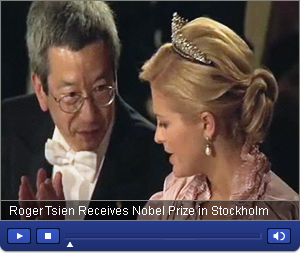
Watch Roger Tsien as he mingles with members of the Swedish royal family and talks about the whirlwind of events he took part in during Nobel Week. Tsien received his Nobel Prize in Chemistry Dec. 10 in Stockholm.
Tsien kept the paper as a memento of his week in Sweden in early December, along with his Nobel medal, his diploma and several other newspaper clippings. Tsien received the Nobel Prize in chemistry Dec. 10 in Stockholm, along with Osamu Shimomura of the Marine Biological Laboratory in Woods Hole and Boston University School of Medicine, and Martin Chalfie of Columbia University in New York. The scientists were recognized for the discovery of the Green Fluorescent Protein and seminal work to design and create fluorescent molecules that enter cells and light up their inner workings.
Back in his lab in the George Palade Laboratories at UC San Diego, Tsien recently reflected on receiving the Prize, his whirlwind week in Sweden and a meeting with President George W. Bush at the White House last year.
The UCSD community will get a flavor of Tsien's experiences in Stockholm Feb. 18, when the Nobel laureate will talk about his time in Sweden and give a lecture about his research at 4 p.m. at the Price Center Theater. The talk is open to students, faculty and staff members.
“The Swedes know how to throw a party,” Tsien said. “This is sort of their version of the Oscars.”
The day before the awards ceremony and the ensuing banquet, Swedish newspapers carried stories with graphics showing the evening’s seating chart. The charts even predicted who would carry on an interesting conversation. The day after the ceremony and banquet, news outlets ran lavish photo spreads of the event.
Awards and banquets
During the awards ceremony, Tsien received his medal and diploma from King Carl XVI Gustaf of Sweden. The two talked later and the king turned out to be a big fan of UCSD alumnus J. Craig Venter. The monarch was thrilled to hear that Venter was closely involved with his alma mater. “(The king) was very excited about the prospect of combining sailing with gene discovery,” Tsien recalled.
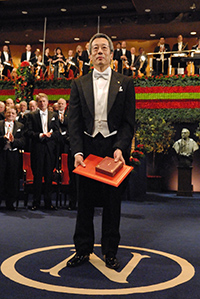
Roger Y. Tsien received the Nobel Prize in Chemistry Dec. 10 in Stockholm.
Photo / Hans Mehlin,
© The Nobel Foundation 2008
At the banquet, Tsien found himself sitting near Princess Madeleine with whom he discussed birth order. Both are younger siblings in their families. Guests at the banquet dined on sole with Swedish shellfish, fennel and dill; fillet of veal, accompanied by seasonal vegetables and potato terrine; and Poire Belle Hélène, a French desert that traditionally pairs poached pears with chocolate sauce and vanilla ice cream. French and German wines and liquors also were on hand, according to a menu posted on the Nobel Foundation Web site.
Perhaps one of the high points of Tsien’s trip to Stockholm came during the Dec. 8 classical music concert that is part of the week-long festivities. The program included Dvořák's symphony No. 7 and Mozart's mass in C minor. Tsien had gone to the library before hand to take out the scores and refresh his memory. During the performance, well-known conductor Sir John Eliot Gardiner came together with the Swedish Royal Philharmonic, the choir and the soloists to produce a high-energy interpretation of the two works. “It was just so vivid,” Tsien said.
The other laureates
Tsien also got to mingle with fellow Nobel Prize winners. He had already met economics laureate and New York Times columnist Paul Krugman during a photo-op at the White House with President Bush. In Stockholm, the two sat by Princess Madeleine during the Nobel banquet. Tsien also had what he describes as a moderately interesting conversation with Jean-Marie Le Clézio, the French Nobel laureate in literature. Talking to the laureates in medicine, who worked on the human papilloma virus and HIV/AIDS was no problem for the UCSD researcher, who is trained in biology and biochemistry.
But even Tsien was stumped when trying to talk to the two Japanese physics laureates who had come to Stockholm. One spoke no English. “And to be honest, the particle physics, or the theoretical physics, that they did is relatively hard for non-specialists to follow,” Tsien said. “It was pretty much way over my head."
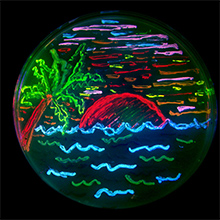
An image drawn with fluorescent bacteria colonies on an agar plate.
Tsien traveled to Stockholm with his wife, Wendy, their siblings, nieces and nephews, as well as current and former colleagues. The researcher spent part of the week trying to make sure that family and friends got into as many events as possible. “It's really quite a difficult matter to try to keep everybody happy,” he said. “I'm not sure I did."
He and Columbia University Professor Chalfie also split the cost of flying to Sweden the man who originally provided them with a copy of the jellyfish gene that produces the Green Fluorescent Protein, Douglas Prasher. Prasher has since dropped out of science and had taken a job as a courtesy shuttle driver to pay the bills. “We could not have done it without the gift of this original GFP seed DNA from Prasher and so it seemed entirely appropriate that he should be acknowledged,” Tsien said. Prasher and his wife seemed to have a great time in Stockholm, he added.
An abundance of speeches
But the week-long stay in Stockholm wasn’t all fancy meals and socializing for Tsien. He gave about a half a dozen speeches, countless interviews and posed for many pictures. He of course gave his Nobel lecture detailing his work. In addition, he gave a research talk at Stockholm University, a speech at a local high school and another for members of the Swedish parliament. He also spoke at the Nobel banquet, after the awards ceremony.
During that speech, Tsien warned that global warming and pollution are threatening corals and jelly fish, which are the very sources of the fluorescent molecules he uses in his lab and could be the sources of many more scientific breakthroughs. “While environmentally friendly or so-called "green" chemistry has become all the rage in the chemical community, no human chemist can yet match what a single jellyfish gene directs,” he said, according to a transcript of his speech available on the Nobel Foundation Web site.
“Corals produce yellow and red fluorescent proteins with the same chemistry,” Tsien went on. “Yet coral reefs are also under world-wide jeopardy, due to acidification and warming of the oceans. So my final thanks are to both the jellyfish and corals: long may they have intact habitats in which to shine!”
The prize’s aftermath
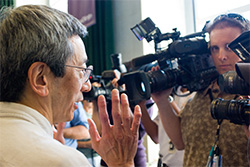
Prof. Roger Tsien surrounded by TV cameras during a press conference the day he received the Nobel Prize.
Ironically, getting government funding for his research might just have gotten more difficult, as agencies like to show that they don’t grant Nobel laureates special treatment, Tsien said during a later interview at UCSD. But receiving funds from other sources, especially to translate discoveries to a clinical setting, is another story. “That I expect must have gotten a little bit easier, by having, as I like to call it, some Swedish fairy dust sprinkled on," he said.
Since he has received the prize, Tsien occasionally is recognized in restaurants and at the library. He also is swamped with invitations to speak in a wide range of venues, including conferences that have nothing to do with his field. “Again, I'm not really any more deserving, but people like the imprimatur that the Swedes have given," Tsien said.
“Why would someone invite me to be a keynote speaker for a soybean research conference?” he wondered.
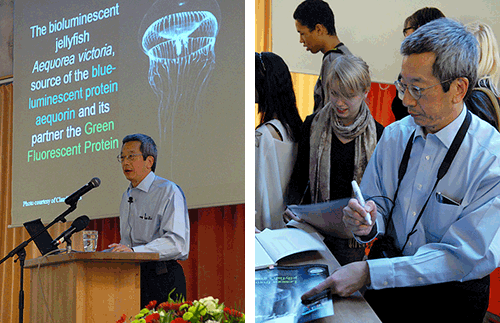
Tsien during one of the many talks he gave in Stockholm. This one took place Dec. 12 at the Värmdö Gymnasium School.
Photo/ Karin Svanholm
© The Nobel Foundation 2008
Tsien signs autographs for high school students during a visit to the Värmdö Gymnasium School in Stockholm.
Photo/ Karin Svanholm
© The Nobel Foundation 2008

|